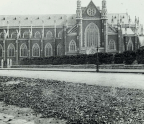The real-life Crusoes of Sunday Island

It sounds more like Victorian juvenile fiction than history, but as the true story of the Bells of Sunday Island shows, the thrilling South Sea adventures penned by some of the 19th century’s bestselling novelists – Robert Louis Stevenson, R. M. Ballantyne, and Johann David Wyss – owed more to reality than many modern readers realise.
In 1878, Yorkshireman Thomas Bell and his family became voluntary Crusoes on Sunday Island – now called Raoul, or Rangit?hua in Maori. An archetypal patriarchal pioneer with an adventurous and restless spirit, Bell was only in his mid teens when he set sail from England for New Zealand, with dreams of the goldfields. He actually found his first job on an Otago sheep farm, and then worked his way up the country to Hawke’s Bay. A few years later, seeing the need for medical professionals in Napier, he persuaded his parents, a doctor and a nurse previously based in Leeds, to join him there. By 1863, Thomas Bell had
You’re reading a preview, subscribe to read more.
Start your free 30 days



